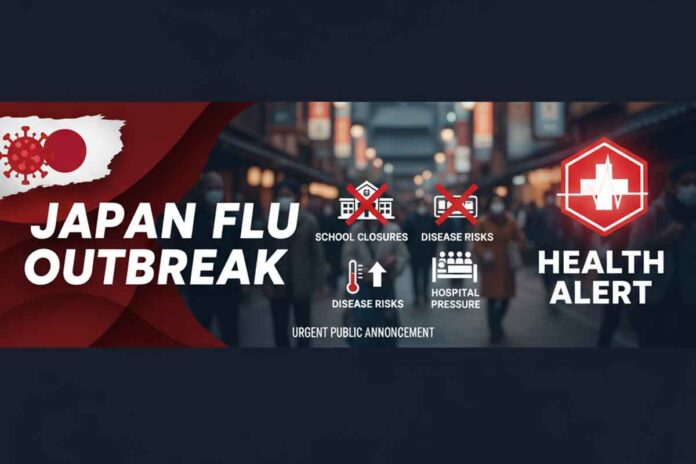The ongoing Japan Flu Outbreak has become a growing public health concern, with thousands hospitalized and schools across several prefectures temporarily closed. Health officials report that hospitals are struggling to manage rising patient numbers. The outbreak, driven by an aggressive influenza strain, appears to have started earlier than the usual flu season and is spreading rapidly across the country.
Experts believe climate fluctuations, lower post-pandemic immunity levels, and viral mutations may be contributing to this sudden surge. Japan’s National Institute of Infectious Diseases has urged local governments to reinforce public health measures and increase vaccination coverage.
Causes and Symptoms
The Japan Flu is caused by influenza viruses that spread through respiratory droplets when an infected person coughs, sneezes, or talks. Transmission is faster in closed, crowded, or poorly ventilated environments such as schools and offices.
Common Symptoms Include:
- High fever and chills
- Cough and sore throat
- Fatigue and muscle pain
- Headache and nasal congestion
- Loss of appetite and weakness
Severe cases may lead to complications like pneumonia or bronchitis, particularly in elderly individuals, children, and those with existing health conditions such as asthma or diabetes. Doctors also caution that some flu strains may be mutating, which could make them more contagious or resistant to certain antiviral drugs.
Prevention Tips
Health authorities recommend preventive actions similar to those used during seasonal influenza outbreaks. Simple steps can significantly reduce your risk of infection:
- Get a flu vaccine annually — it remains the best protection against severe disease.
- Wash your hands regularly with soap and water for at least 20 seconds.
- Wear a mask in crowded indoor settings or public transport.
- Maintain good ventilation at home, school, and workplace.
- Stay home and rest if you experience flu-like symptoms to prevent spreading infection.
Japan’s health ministry has also urged citizens to seek medical help promptly if they develop persistent high fever or breathing difficulties.
Fitness and Diet Advice
Maintaining good health and a strong immune system helps in preventing infections and speeding up recovery. Doctors recommend adopting a healthy lifestyle that includes:
- Balanced Diet: Eat fruits rich in vitamin C, vegetables, whole grains, and lean protein.
- Stay Hydrated: Drink plenty of fluids to keep your body hydrated and flush out toxins.
- Light Exercise: Activities like yoga, brisk walking, or stretching help boost circulation and immunity.
- Proper Rest: Get at least 7–8 hours of quality sleep to support your immune function.
Treatment: Advantages and Disadvantages
Treatment for the Japan Flu depends on symptom severity. Most mild cases can be managed at home with rest, hydration, and fever control, while severe cases may require antiviral medication and hospital care.
Advantages of Treatment:
- Early antiviral use can shorten the duration and intensity of symptoms.
- Hydration and rest aid faster recovery and help prevent complications.
- Medical monitoring ensures timely response to worsening symptoms.
Disadvantages of Treatment:
- Antivirals may be less effective if started late.
- Overuse of medication could lead to resistance in certain flu strains.
- Hospitals may face overcrowding, delaying treatment for some patients.
Public Health Situation in Japan
As of mid-October 2025, more than 4,000 people have been hospitalized across Japan due to the flu outbreak. Over 100 schools have temporarily closed to control the spread, and hospitals in Tokyo, Osaka, and Hokkaido are operating near full capacity. Officials have reassured the public that vaccine supplies are sufficient and that containment measures are underway.
Disclaimer
This article is for informational purposes only. It should not replace professional medical advice, diagnosis, or treatment. If you are experiencing symptoms, consult a certified healthcare provider for appropriate guidance and medication.
FAQs
Q1: What is causing the Japan Flu Outbreak?
The outbreak is likely caused by a stronger-than-usual influenza strain combined with fluctuating weather conditions and lower immunity levels after several mild flu seasons.
Q2: Who is most at risk from the Japan Flu?
Children, older adults, and people with chronic diseases are at the highest risk of complications. Vaccination and early treatment are strongly recommended for these groups.
Q3: How can I protect myself from Japan Flu?
Maintain good hygiene, get vaccinated, wear a mask in public, and avoid close contact with sick individuals. Staying healthy through good diet and regular exercise also helps build resistance.



